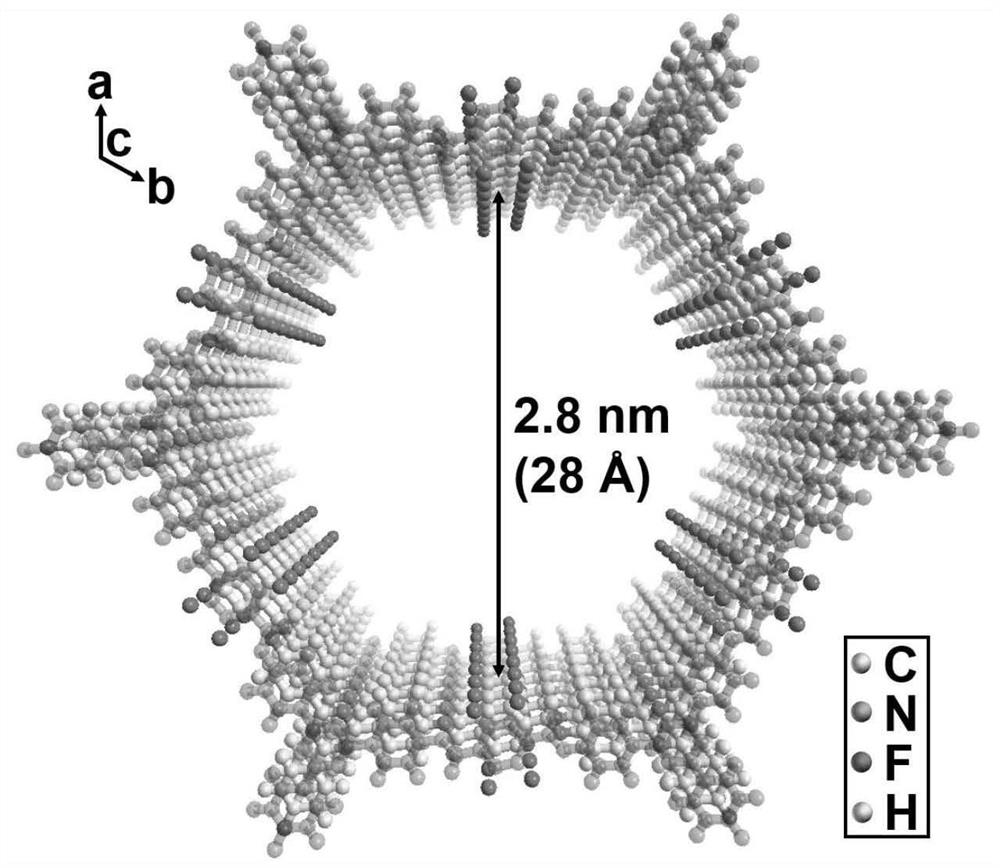Covalent organic framework material, solid-phase micro-extraction probe and preparation method and application of solid-phase micro-extraction probe
A technology of covalent organic framework and probe, applied in the field of chemistry
- Summary
- Abstract
- Description
- Claims
- Application Information
AI Technical Summary
Problems solved by technology
Method used
Image
Examples
Embodiment 1
[0036] Example 1: Preparation of a covalent organic framework material for highly selective adsorption of perfluorinated and polyfluoroalkyl compounds
[0037] Preparation of a covalent organic framework material for highly selective adsorption of perfluorinated and polyfluoroalkyl compounds (see figure 1 ), the process involves the mixing of reaction raw materials and solvents, the addition of catalysts, the formation of imine products under certain conditions and the post-treatment of products. details as follows:
[0038]First, mix 2,3,5,6-tetrafluoro-p-benzaldehyde and 2,4,6-(4-aminophenyl)-1,3,5-triazine monomers in a stoichiometric ratio of 3:2 , wherein the dosage of 2,3,5,6-tetrafluoro-p-benzaldehyde is 61.8mg, and the dosage of 2,4,6-(4-aminophenyl)-1,3,5-triazine is 70.9mg; Then add 3.5mL of N,N-dimethylformamide, sonicate until the reactant is completely dissolved, then add 15mL of acetonitrile and 35mL of o-dichlorobenzo and sonicate until mixed; then add 2mL of ...
Embodiment 2
[0039] Example 2: Preparation of a biocompatible solid-phase microextraction probe based on highly selective adsorption of covalent organic framework materials by perfluorinated and polyfluoroalkyl compounds
[0040] Preparation of a biocompatible solid-phase microextraction probe based on perfluorinated and polyfluoroalkyl compounds with high selective adsorption of covalent organic framework materials, using a direct coating method (see Figure 4 ), the process includes etching the probe carrier, coating the adhesive on the etched carrier, adhering the above-mentioned covalent organic framework material powder with the probe carrier coated with the adhesive, curing the adhesive, biocompatible Coating modification and probe post-processing.
[0041] First, take a 304 stainless steel needle (diameter 0.5 mm, length 3 cm), and ultrasonically clean it in acetone, ultrapure water and methanol for 30 minutes to remove surface impurities; then, immerse the stainless steel needle in...
Embodiment 3
[0042] Example 3: Study on the adsorption capacity of COFs-SPME
[0043] Under optimized experimental conditions, COFs-SPME and open nano-electrospray mass spectrometry were used to analyze a series of concentrations of perfluorooctane sulfonic acid (PFOS) in pure water spiked solutions to study the adsorption capacity of COFs-SPME probes .
[0044] It was observed that the adsorption saturation concentration of COFs-SPME probe to PFOS was 50ng / μL (see Figure 5 ). Then, under the same experimental conditions, the standard solution of PFOS in methanol solution was analyzed by nano-electrospray mass spectrometry, and it was found that the concentration that produced the same signal intensity as saturated extraction was 1.2 μg / μL. Since 2 μL of methanol was used for desorption during the analysis, the adsorption capacity of the COFs-SPME probe was calculated to be 2.4 μg of PFOS.
PUM
| Property | Measurement | Unit |
|---|---|---|
| adsorption capacity | aaaaa | aaaaa |
Abstract
Description
Claims
Application Information
 Login to View More
Login to View More - R&D
- Intellectual Property
- Life Sciences
- Materials
- Tech Scout
- Unparalleled Data Quality
- Higher Quality Content
- 60% Fewer Hallucinations
Browse by: Latest US Patents, China's latest patents, Technical Efficacy Thesaurus, Application Domain, Technology Topic, Popular Technical Reports.
© 2025 PatSnap. All rights reserved.Legal|Privacy policy|Modern Slavery Act Transparency Statement|Sitemap|About US| Contact US: help@patsnap.com



